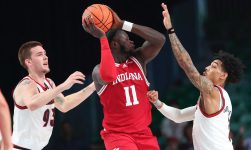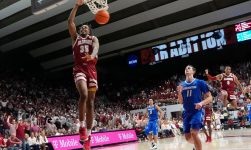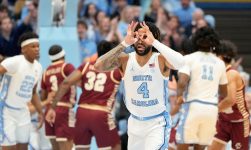The Big 12 just took a long-awaited swipe at the Pac-12 as it poached Colorado away from the West Coast-based league with the Buffaloes set to settle back into their former home in 2024. Colorado will return to an iteration of the league it played in consistently for 70 years before the Pac-12 move.
So now that the floodgates have opened, will the dam break? The Big 12 has been aggressive in its pursuit of the so-called “Four Corners schools.” Meanwhile, otther Pac-12 and Group of Five programs could also be considered as the Big 12 potentially looks to grow in the coming weeks.
Big 12 commissioner Brett Yormark has not operated like traditional commissioner since he took the job almost a year ago. Almost from the beginning, he telegraphed his intention to be a national conference and double down on basketball. Will the strategy work? Here are some potential Big 12 expansion candidates as the realignment carousel is spinning once again.
Power Five options
Arizona: If the Big 12 only adds one more Power Five school, the Wildcats are top priority. Arizona fits well within the elite basketball configuration of the Big 12 and has invested well on the football side of things under third-year coach Jedd Fisch. Getting into the American Southwest has long been a target for the Big 12, and connecting through Colorado and Provo, Utah (BYU), makes the add a no-brainer. Arizona president Robert Robbins has been on the record saying that he is comfortable waiting for the financials tied a Pac-12 media deal before making a decision. More than a year after negotiations started, the Pac-12 has not delivered one, which ultimately led the Buffaloes to defect. If the number finally comes in, will Arizona pull the rip cord if brass aren’t satisfied?
Arizona State: Arizona State boasts one of the largest enrollments and alumni bases in the nation but without much athletic success. The Sun Devils are breaking in a new football coach and have not won an NCAA Tournament game since 2009. It’s also unclear whether Arizona State is attached at the hip with Arizona. All three major public universities in Arizona — Arizona, Arizona State, Northern Arizona — are run by the same Board of Regents a setup which has often created conflict. How would it work if the two schools sat in different conferences?
Utah: There’s been little appetite from Utah higher-ups to leave the Pac-12, especially since the Utes have won back-to-back conference titles and enjoyed time in the national spotlight. A move to the Big 12 would involve sharing a conference with in-state rival BYU. There’s plenty of space for both in the football-hungry Utah market, but it’s a competitive factor to consider. After traveling through the non-power leagues for so long, Utah also has great geographic and cultural overlap with the Pac-12, which may not be true in the Big 12. What could ultimately stack the deck is the Pac-12 delivering a poor television contract. At that point, all bets are off.
Group of Five options
UConn: The Huskies are one of the biggest enigmas of realignment but are believed to be a top priority for the Big 12 if it can’t add another Power Five program. UConn won the most recent basketball national championship and brings the Big 12 into a Northeast region where Yormark spent most of his career. However, the Huskies have also fielded a notably horrendous football program recently, going 27-83 since the Big East folded. Jim Mora Jr. led the program to a 6-7 record in 2022, so there is some hope. In the end, the Big 12 will have to balance the value of adding a game-changing basketball property — both men’s and women’s — but essentially sacrificing a football slot.
San Diego State: The Aztecs’ connection to the Pac-12 has been long reported, but things came to a head in June when San Diego State publicly put the ball in the Pac-12’s court and were awkwardly rebuffed. It still remains likely the Pac-12 eventually adds the Aztecs to try and remain in the Southern California footprint, but a Pac-12 collapse could change the odds. San Diego State isn’t a perfect fit for the Big 12, but it would lock up a spot in the Pacific Time Zone, which has been a priority for Yormark. The football and basketball programs have been historically very good.
UNLV: Going to Las Vegas would be a long-term market play as sports leagues across the country try to grow some roots. The Rebels play at the new Raiders-owned Allegiant Stadium in a sports market that could soon add an MLB team (Oakland A’s). UNLV has a proud basketball history but has failed to make an NCAA Tournament since 2013. The football team is a perpetual afterthought, and former Missouri coach Barry Odom might not be splashy enough to give the Big 12 much optimism. However, Las Vegas remains one of the fastest-growing metros in the United States, so a gamble has to be on the table.
Memphis: Nearly 10 years ago the Tigers looked like a no-brainer in realignment. Unfortunately, the current state of affairs has left Memphis in a strange position even two years after getting snubbed from the Big 12. The football team has put together a pedestrian 21-15 record in the three seasons since Mike Norvell left. The basketball team has been more of a sideshow than contender under Penny Hardaway. Facility investment is on the way, but is it too late? Yormark has historically downplayed interest in Memphis.






